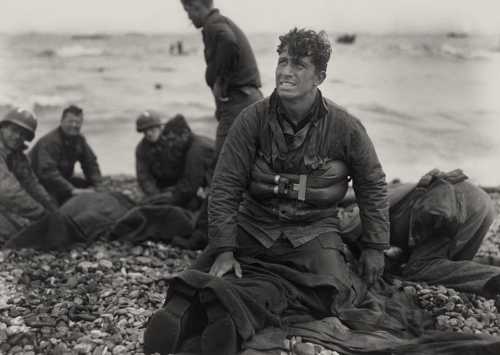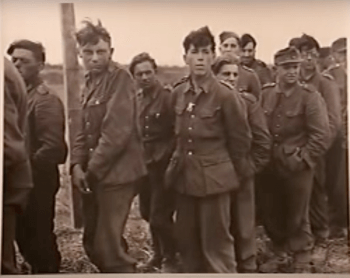D-Day Anniversary: Army war photographer recalls the story of a dramatic rescue photo

Aboard a landing craft en route to Omaha Beach on June 6, 1944, Walter Rosenblum, age 24, had never seen a dead body. But then the hatch opened, exposing troops to German gunfire from the hills overlooking the beach, and the Army war photographer’s world changed.
“Suddenly there are dead people in the water, the water is turning red, they are being washed up and down by the sea,” Rosenblum told USC Shoah Foundation during his interview in 1997. “I figured I’m still around – and I began to take pictures of whatever it is I saw.”
Then a draftee from New York City, Rosenblum was among the 156,000 Allied troops to storm the beaches of Normandy on what is now known as D-Day – 74 years ago today.
Known as the beginning of the end of World War II, D-Day enabled the Americans, British and Canadians to establish a huge presence of troops – 326,000 strong by week’s end – in Normandy, France. After losing some 4,000 soldiers in the invasion, the Allied forces advanced through countryside and marshes of France against fierce German resistance. They liberated Paris in late August, less than three months after their arrival.
Among the photos Rosenblum took during the mayhem on the morning of D-Day was an iconic shot of an exhausted young lieutenant on a rocky beach, gazing past the camera while he and several others perform first aid on a group of men they’d tried to rescue from a wrecked boat, which can be seen sinking in the blurry background. Today, the photo belongs to the Art Institute of Chicago.
 Rescue attempt on the morning of D-Day. Photo by Walter Rosenblum.
Rescue attempt on the morning of D-Day. Photo by Walter Rosenblum. (Rosenblum would also become the first Allied photographer who set foot in the newly liberated Dachau concentration camp in the spring of 1945.)
In his testimony, Rosenblum – who died in 2006 – told the story behind the photo of the soldiers on Omaha Beach.
He watched as the young lieutenant and two other men hopped into a rescue boat and rushed to the aid of two or three men trapped on a shelled landing craft that was going down.
“I filmed the whole sequence: Getting into the boat, going out, rescuing the people, bringing them back into the boat, giving them first aid on the shore,” he said. The photos ran as a series in the Army weekly magazine, Yank.
Rosenblum would meet the lieutenant by accident 40 years later. Rosenblum was speaking on a panel at Columbia University; the lieutenant was speaking on another panel at the same conference, where some of Rosenblum's photos were on display.
 Captured German soldiers. Photo by Walter Rosenblum.
Captured German soldiers. Photo by Walter Rosenblum. “He’d recognized himself in the picture,” Rosenblum said.
On the afternoon of D-Day, Rosenblum took another striking shot: a group of young Germans who’d been captured, the expressions on their faces plainly visible.
“What impressed me when we made the photograph is how young they all seemed,” Rosenblum said. “It was as though the Germans knew they were going to lose the Normandy beachheads and took most of the older troops further back inland.”
Rosenblum is among 255 interviewees in USC Shoah Foundation’s Visual History Archive who mention the Allied Invasion of Normandy.
A clip of his testimony also exists on this online exhibit created by USC Shoah Foundation for a French audience.
Like this article? Get our e-newsletter.
Be the first to learn about new articles and personal stories like the one you've just read.